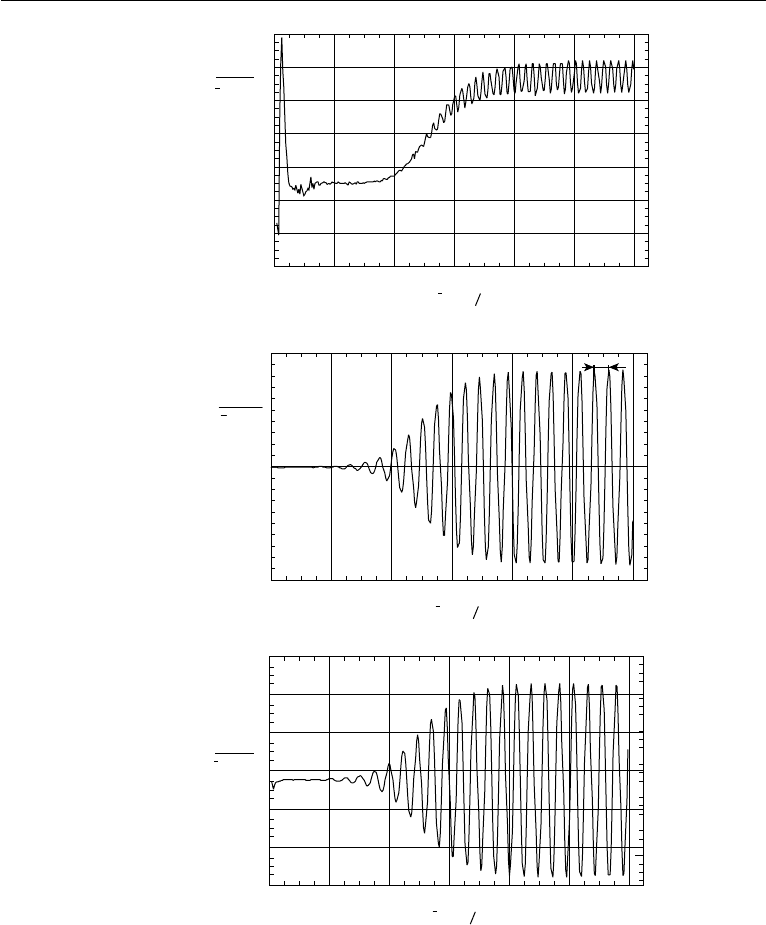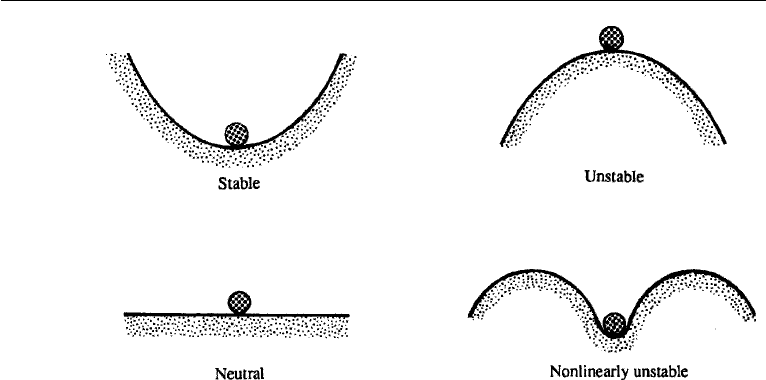Cohen I.M., Kundu P.K. Fluid Mechanics
Подождите немного. Документ загружается.


462 Computational Fluid Dynamics
t = t ⋅ U d
20.006
0 20 40 60 80 100 120
20.004
20.002
0
0.002
0.004
0.006
Torque
1
2
(c)
(a)
1.88
0
20 40 60 80
1.9
1.92
1.94
1.96
1.98
2
2.02
100 120
tb
t = t ⋅ U d
Drag
1
2
t = t ⋅ U d
20.5
20 40 60 80 100 1200
0
0.5
0 0475s
F
y
1
2
(b)
ρU
2
d
2
ρU
2
d
ρU
2
d
Figure 11.21 History of forces and torque acting on the cylinder at Re = 100: (a) drag coefficient; (b) lift
coefficient; and (c) coefficient for the torque.

6. Concluding Remarks 463
to be sure that the numerical solution converges to something meaningful. A similar
test with the time step for unsteady flow problems is often desired. If the boundary
locations and conditions are in doubt, their effects on the CFD predictions should be
minimized. Furthermore, the sensitivity of the CFD predictions to some key param-
eters in the problem should be investigated for practical design problems.
In this chapter, we have discussed the basics of the finite difference and finite
element methods and their applications in CFD. There are other kinds of numer-
ical methods, for example, the spectral method and the spectral element method,
which are often used in CFD. They share the common approach that discretizes
the Navier-Stokes equations into a system of algebraic equations. However, a class
of new numerical techniques including lattice gas cellular automata, lattice Boltz-
mann method, and dissipative particle dynamics do not start from the continuum
Navier-Stokes equations. Unlike the conventional methods discussed in this chapter,
they are based on simplified kinetic models that incorporate the essential physics of
the microscopic or mesoscopic processes so that the macroscopic-averaged properties
obey the desired macroscopic Navier-Stokes equations.
Exercises
1. Show that the stability condition for the explicit scheme (11.10) is the condition
(11.26).
2. For the heat conduction equation ∂T
/
∂t − D
∂
2
T
/
∂x
2
= 0, one of the
discretized forms is
−sT
n+1
j+1
+
(
1 + 2s
)
T
n+1
j
− sT
n+1
j−1
= T
n
j
where s = Dt
/
x
2
. Show that this implicit algorithm is always stable.
3. An insulated rod initially has a temperature of T
(
x,0
)
= 0
◦
C
(
0 x 1
)
.
At t = 0 hot reservoirs
(
T = 100
◦
C
)
are brought into contact with the two ends,
A
(
x = 0
)
and B
(
x = 1
)
: T
(
0,t
)
= T
(
1,t
)
= 100
◦
C. Numerically find the tem-
perature T
(
x,t
)
of any point in the rod. The governing equation of the problem is
the heat conduction equation ∂T
/
∂t − D
∂
2
T
/
∂x
2
= 0. The exact solution to this
problem is
T
∗
x
j
,t
n
= 100 −
M
m=1
400
(
2m − 1
)
π
sin
(
2m − 1
)
πx
j
exp
−D
(
2m − 1
)
2
π
2
t
n
(11.199)
where M is the number of terms used in the approximation.
(a). Try to solve the problem with the explicit forward time, centered space
(FTCS) scheme. Use the parameter s = Dt
/
x
2
=0.5 and 0.6 to test the stability of
the scheme.

464 Computational Fluid Dynamics
(b). Solve the problem with a stable explicit or implicit scheme. Test the rate of
convergence numerically using the error atx = 0.5.
4. Derive the weak form, Galerkin form, and the matrix form of the following
strong problem:
Given functions D(x), f (x), and constants g, h, find u(x) such that
[D(x)u
,x
]
,x
+ f(x)= 0on = (0, 1),
with u(0) = g and − u
,x
(1) = h.
Write a computer program solving this problem using piecewise-linear shape
functions. You may set D = 1, g = 1, h = 1 and h = 1. Check your numerical result
with the exact solution.
5. Solve numerically the steady convective transport equation,
u
∂T
∂x
= D
∂
2
T
∂x
2
, for 0 x 1,
with two boundary conditions T(0) = 0 and T(1) = 1, where u and D are two
constants,
(a) using the centered finite difference scheme in equation (11.91), and compare with
the exact solution; and
(b) using the upwind scheme (11.93), and compare with the exact solution.
6. Code the explicit MacCormack scheme with the FF/BB arrangement for the
driven cavity flow problem as described in Section 5. Compute the flow field at
Re = 100 and 400, and explore effects of Mach number and the stability condition
(11.110).
Literature Cited
Brooks, A. N. and T. J. R. Hughes (1982). “Streamline-upwinding/Petrov-Galerkin formulation for convec-
tion dominated flows with particular emphasis on incompressible Navier-Stokes equation.” Comput.
Methods Appl. Mech. Engrg. 30: 199–259.
Chorin, A. J. (1967). “A numerical method for solving incompressible viscous flow problems.” J. Comput.
Phys. 2: 12–26.
Chorin, A. J. (1968). “Numerical solution of the Navier-Stokes equations.” Math. Comput. 22: 745–762.
Dennis, S. C. R. and G. Z. Chang (1970). “Numerical solutions for steady flow past a circular cylinder at
Reynolds numbers up to 100.” J. Fluid Mech. 42: 471–489.
Fletcher, C. A. J. (1988). Computational Techniques for Fluid Dynamics, I–Fundamental and General
Techniques, and II–Special Techniques for Different Flow Categories, New York: Springer-Verlag.
Franca, L. P., S. L. Frey and T. J. R. Hughes (1992). “Stabilized finite element methods: I. Application to
the advective-diffusive model.” Comput. Methods Appl. Mech. Engrg. 95: 253–276.
Franca, L. P. and S. L. Frey (1992). “Stabilized finite element methods: II. The incompressible
Navier-Stokes equations,”Comput. Methods Appl. Mech. Engrg. 99: 209–233.
Ghia, U., K. N. Ghia, C. T. Shin (1982)
`
ıHigh-Re solutions for incompressible flow using the Navier-Stokes
equations and a multigrid method.
ˆ
ı J. Comput. Phys. 48: 387–411.
Glowinski, R. (1991). “Finite element methods for the numerical simulation of incompressible viscous
flow, introduction to the control of the Navier-Stokes equations,” in Lectures in Applied Mathematics
Vol.28: 219–301. Providence, R.I.: American Mathematical Society.

Literature Cited 465
Gresho, P. M. (1991). “Incompressible fluid dynamics: Some fundamental formulation issues,” Annu. Rev.
Fluid Mech. 23: 413–453.
Harlow, F. H. and J. E. Welch (1965). “Numerical calculation of time-dependent viscous incompressible
flow of fluid with free surface.” Phys. Fluids 8: 2182–2189.
Hou, S., Q. Zou, S. Chen, G. D. Doolen and A. C. Cogley (1995).
`
ıSimulation of cavity flow by the lattice
Boltzmann method.
ˆ
ı J. Comp. Phys. 118: 329–347.
Hughes, T. J. R. (1987). The Finite Element Method, Linear Static and Dynamic Finite Element Analysis,
Englewood Cliffs, NJ: Prentice-Hall.
MacCormack, R. W. (1969). “The effect of viscosity in hypervelocity impact cratering.” AIAA Paper
69–354, Cincinnati, Ohio.
Marchuk, G. I. (1975). Methods of Numerical Mathematics, New York: Springer-Verlag.
Noye, J (1983). Chapter 2 in Numerical Solution of Differential Equations, J. Noye, ed., Amsterdam:
North-Holland.
Oden, J. T. and G. F. Carey (1984). Finite Elements: Mathematical Aspects, Vol. IV, Englewood Cliffs,
N.J.: Prentice-Hall.
Perrin, A. and H.H. Hu (2006). “An explicit finite-difference scheme for simulation of moving particles,”
J. Comput. Phys. 212: 166–187.
Peyret, R. and T. D. Taylor (1983). Computational Methods for Fluid Flow, New York: Springer-Verlag.
Richtmyer, R. D. and K. W. Morton (1967). Difference Methods for Initial-Value Problems, New York:
Interscience.
Saad, Y. (1996). Iterative Methods for Sparse Linear Systems, Boston: PWS Publishing Company.
Sucker, D. and H. Brauer (1975). “Fluiddynamik bei der angestr
¨
omten Zylindern.” W
¨
arme-Stoff¨ubertrag.
8: 149.
Takami, H. and H. B. Keller (1969). “Steady two-dimensional viscous flow of an incompressible fluid past
a circular cylinder.” Phys. Fluids 12: Suppl.II, II-51-II-56.
Tannehill, J. C., D. A. Anderson, R. H. Pletcher (1997), Computational Fluid Mechanics and Heat Transfer,
Washington, DC, Taylor & Francis.
Temam, R. (1969). “Sur l’approximation des
´
equations de Navier-Stokes par la m
´
ethode de pas fraction-
aires.” Archiv. Ration. Mech. Anal. 33: 377–385.
Tezduyar, T. E. (1992). “Stabilized Finite Element Formulations for Incompressible Flow Computations,”
in Advances in Applied Mechanics , J.W. Hutchinson and T.Y. Wu eds., Vol. 28: 1–44. New York:
Academic Press.
Yanenko, N. N. (1971). The Method of Fractional Steps, New York: Springer-Verlag.
Wen, C. Y. and C. Y. Lin (2001). “Two dimensional vortex shedding of a circular cylinder,” Phys. Fluids
13: 557–560.
This page intentionally left blank

Chapter 12
Instability
1. Introduction......................... 467
2. Method of Normal Modes ............ 469
3. Thermal Instability: The B´enard
Problem............................. 470
Formulation of the Problem ......... 471
Proof That σ Is Real for Ra > 0 ...... 475
Solution of the Eigenvalue Problem
with Two Rigid Plates ............. 477
Solution with Stress-Free Surfaces . . . 480
Cell Patterns ........................ 481
4. Double-Diffusive Instability .......... 482
Finger Instability .................... 482
Oscillating Instability ................ 485
5. Centrifugal Instability:
Taylor Problem ..................... 486
Rayleigh’s Inviscid Criterion ......... 486
Formulation of the Problem ......... 488
Discussion of Taylor’s Solution ....... 490
6. Kelvin–Helmholtz Instability ......... 493
7. Instability of Continuously
Stratified Parallel Flows ............. 500
Taylor–Goldstein Equation .......... 500
Richardson Number Criterion........ 503
Howard’s Semicircle Theorem ....... 504
8. Squire’s Theorem and
Orr–Sommerfeld Equation ........... 507
Squire’s Theorem.................... 509
Orr–Sommerfeld Equation........... 509
9. Inviscid Stability of Parallel Flows . . 510
Rayleigh’s Inflection Point Criterion . 511
Fjortoft’s Therorm ................. 511
Critical Layers ..................... 512
10. Some Results of Parallel Viscous
Flows .............................. 514
Mixing Layer ...................... 515
Plane Poiseuille Flow ............... 516
Plane Couette Flow................. 516
Pipe Flow .......................... 516
Boundary Layers with Pressure
Gradients ........................ 517
How can Viscosity Destabilize a
Flow? ........................... 519
11. Experimental Verification of
Boundary Layer Instability ......... 520
12. Comments on Nonlinear Effects ..... 522
13. Transition .......................... 523
14. Deterministic Chaos ................ 525
Phase Space ....................... 526
Attractor........................... 527
The Lorenz Model of Thermal
Convection ...................... 528
Strange Attractors .................. 530
Scenarios for Transition to Chaos . . . 531
Closure ............................ 533
Exercises ........................... 533
Literature Cited .................... 535
1. Introduction
A phenomenon that may satisfy all conservation laws of nature exactly, may still
be unobservable. For the phenomenon to occur in nature, it has to satisfy one more
condition, namely, it must be stable to small disturbances. In other words, infinitesi-
mal disturbances, which are invariably present in any real system, must not amplify
467
©2010 Elsevier Inc. All rights reserved.
DOI: 10.1016/B978-0-12-381399-2.50012-5

468 Instability
Figure 12.1 Stable and unstable systems.
spontaneously. A perfectly vertical rod satisfies all equations of motion, but it does
not occur in nature. A smooth ball resting on the surface of a hemisphere is stable (and
therefore observable) if the surface is concave upwards, but unstable to small displace-
ments if the surface is convex upwards (Figure 12.1). In fluid flows, smooth laminar
flows are stable to small disturbances only when certain conditions are satisfied. For
example, in flows of homogeneous viscous fluids in a channel, the Reynolds number
must be less than some critical value, and in a stratified shear flow, the Richardson
number must be larger than a critical value. When these conditions are not satisfied,
infinitesimal disturbances grow spontaneously. Sometimes the disturbances can grow
to a finite amplitude and reach equilibrium, resulting in a new steady state. The new
state may then become unstable to other types of disturbances, and may grow to yet
another steady state, and so on. Finally, the flow becomes a superposition of various
large disturbances of random phases, and reaches a chaotic condition that is com-
monly described as “turbulent.” Finite amplitude effects, including the development
of chaotic solutions, will be examined briefly later in the chapter.
The primary objective of this chapter, however, is the examination of stability
of certain fluid flows with respect to infinitesimal disturbances. We shall introduce
perturbations on a particular flow, and determine whether the equations of motion
demand that the perturbations should grow or decay with time. In this analysis the
problem is linearized by neglecting terms quadratic in the perturbation variables
and their derivatives. This linear method of analysis, therefore, only examines the
initial behavior of the disturbances. The loss of stability does not in itself constitute
a transition to turbulence, and the linear theory can at best describe only the very
beginning of the process of transition to turbulence. Moreover, a real flow may be
stable to infinitesimal disturbances (linearly stable), but still can be unstable to suffi-
ciently large disturbances (nonlinearly unstable); this is schematically represented in
Figure 12.1. These limitations of the linear stability analysis should be kept in mind.

2. Method of Normal Modes 469
Nevertheless, the successes of the linear stability theory have been considerable.
For example, there is almost an exact agreement between experiments and theoretical
prediction of the onset of thermal convection in a layer of fluid, and of the onset of
the Tollmien–Schlichting waves in a viscous boundary layer. Taylor’s experimental
verification of his own theoretical prediction of the onset of secondary flow in a
rotating Couette flow is so striking that it has led people to suggest that Taylor’s
work is the first rigorous confirmation of Navier–Stokes equations, on which the
calculations are based.
For our discussion we shall choose problems that are of importance in geophysical
as well as engineering applications. None of the problems discussed in this chapter,
however, contains Coriolis forces; the problem of “baroclinic instability,” which does
contain the Coriolis frequency, is discussed in Chapter 14. Some examples will also
be chosen to illustrate the basic physics rather than any potential application. Further
details of these and other problems can be found in the books by Chandrasekhar
(1961, 1981) and Drazin and Reid (1981). The review article by Bayly, Orszag, and
Herbert (1988) is recommended for its insightful discussions after the reader has read
this chapter.
2. Method of Normal Modes
The method of linear stability analysis consists of introducing sinusoidal disturbances
on a basic state (also called background or initial state), which is the flow whose
stability is being investigated. For example, the velocity field of a basic state involving
a flow parallel to the x-axis, and varying along the y-axis, is U =[U(y),0, 0 ].On
this background flow we superpose a disturbance of the form
u(x,t) =ˆu( y) e
ikx+imz+σt
, (12.1)
where ˆu(y) is a complex amplitude; it is understood that the real part of the right-hand
side is taken to obtain physical quantities. (The complex form of notation is explained
in Chapter 7, Section 15.) The reason solutions exponential in (x,z,t) are allowed
in equation (12.1) is that, as we shall see, the coefficients of the differential equation
governing the perturbation in this flow are independent of (x,z,t). The flow field is
assumed to be unbounded in the x and z directions, hence the wavenumber components
k and m can only be real in order that the dependent variables remain bounded as x,
z →∞; σ = σ
r
+ iσ
i
is regarded as complex.
The behavior of the system for all possible K =[k, 0,m] is examined in the
analysis. If σ
r
is positive for any value of the wavenumber, the system is unstable to
disturbances of this wavenumber. If no such unstable state can be found, the system
is stable. We say that
σ
r
< 0: stable,
σ
r
> 0: unstable,
σ
r
= 0: neutrally stable.

470 Instability
The method of analysis involving the examination of Fourier components such as
equation (12.1) is called the normal mode method. An arbitrary disturbance can be
decomposed into a complete set of normal modes. In this method the stability of each
of the modes is examined separately, as the linearity of the problem implies that the var-
ious modes do not interact. The method leads to an eigenvalue problem, as we shall see.
The boundary between stability and instability is called the marginal state, for
which σ
r
= 0. There can be two types of marginal states, depending on whether σ
i
is
also zero or nonzero in this state. If σ
i
= 0 in the marginal state, then equation (12.1)
shows that the marginal state is characterized by a stationary pattern of motion;
we shall see later that the instability here appears in the form of cellular convection or
secondary flow (see Figure 12.12 later). For such marginal states one commonly says
that the principle of exchange of stabilities is valid. (This expression was introduced
by Poincar´e and Jeffreys, but its significance or usefulness is not entirely clear.)
If, on the other hand, σ
i
= 0 in the marginal state, then the instability sets in as
oscillations of growing amplitude. Following Eddington, such a mode of instability
is frequently called “overstability” because the restoring forces are so strong that the
system overshoots its corresponding position on the other side of equilibrium. We
prefer to avoid this term and call it the oscillatory mode of instability.
The difference between the neutral state and the marginal state should be noted
as both have σ
r
= 0. However, the marginal state has the additional constraint that it
lies at the borderline between stable and unstable solutions. That is, a slight change
of parameters (such as the Reynolds number) from the marginal state can take the
system into an unstable regime where σ
r
> 0. In many cases we shall find the stability
criterion by simply setting σ
r
= 0, without formally demonstrating that it is indeed
at the borderline of unstable and stable states.
3. Thermal Instability: The B´enard Problem
A layer of fluid heated from below is “top heavy,” but does not necessarily undergo
a convective motion. This is because the viscosity and thermal diffusivity of the
fluid try to prevent the appearance of convective motion, and only for large enough
temperature gradients is the layer unstable. In this section we shall determine the
condition necessary for the onset of thermal instability in a layer of fluid.
The first intensive experiments on instability caused by heating a layer of fluid
were conducted by B´enard in 1900. B´enard experimented on only very thin layers
(a millimeter or less) that had a free surface and observed beautiful hexagonal cells
when the convection developed. Stimulated by these experiments, Rayleigh in 1916
derived the theoretical requirement for the development of convective motion in a
layer of fluid with two free surfaces. He showed that the instability would occur when
the adverse temperature gradient was large enough to make the ratio
Ra =
gαd
4
κν
,
(12.2)

3. Thermal Instability: The B´enard Problem 471
exceed a certain critical value. Here, g is the acceleration due to gravity, α is the
coefficient of thermal expansion, =−d
¯
T/dz is the vertical temperature gradient
of the background state, d is the depth of the layer, κ is the thermal diffusivity, and ν is
the kinematic viscosity. The parameter Ra is called the Rayleigh number, and we shall
see shortly that it represents the ratio of the destabilizing effect of buoyancy force to
the stabilizing effect of viscous force. It has been recognized only recently that most
of the motions observed by B´enard were instabilities driven by the variation of surface
tension with temperature and not the thermal instability due to a top-heavy density
gradient (Drazin and Reid 1981, p. 34). The importance of instabilities driven by
surface tension decreases as the layer becomes thicker. Later experiments on thermal
convection in thicker layers (with or without a free surface) have obtained convective
cells of many forms, not just hexagonal. Nevertheless, the phenomenon of thermal
convection in a layer of fluid is still commonly called the B´enard convection.
Rayleigh’s solution of the thermal convection problem is considered a major
triumph of the linear stability theory. The concept of critical Rayleigh number finds
application in such geophysical problems as solar convection, cloud formation in the
atmosphere, and the motion of the earth’s core.
Formulation of the Problem
Consider a layer confined between two isothermal walls, in which the lower wall is
maintained at a higher temperature. We start with the Boussinesq set
∂ ˜u
i
∂t
+˜u
j
∂ ˜u
i
∂x
j
=−
1
ρ
0
∂ ˜p
∂x
i
− g[1 − α(
˜
T − T
0
)]δ
i3
+ ν∇
2
˜u
i
,
∂
˜
T
∂t
+˜u
j
∂
˜
T
∂x
j
= κ∇
2
˜
T,
(12.3)
along with the continuity equation ∂ ˜u
i
/∂x
i
= 0. Here, the density is given by the
equation of state ˜ρ = ρ
0
[1 − α(
˜
T − T
0
)], with ρ
0
representing the reference density
at the reference temperature T
0
. The total flow variables (background plus perturba-
tion) are represented by a tilde ( ˜), a convention that will also be used in the follow-
ing chapter. We decompose the motion into a background state of no motion, plus
perturbations:
˜u
i
= 0 + u
i
(x,t),
˜
T =
¯
T(z)+ T
(x,t),
˜p = P(z)+ p(x,t),
(12.4)
where the z-axis is taken vertically upward. The variables in the basic state are
represented by uppercase letters except for the temperature, for which the symbol is
¯
T .
The basic state satisfies
0 =−
1
ρ
0
∂P
∂x
i
− g[1 − α(
¯
T − T
0
)]δ
i3
,
0 = κ
d
2
¯
T
dz
2
.
(12.5)
